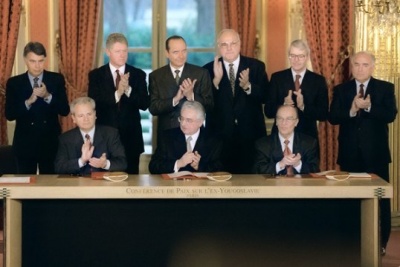Difference between revisions of "The Dayton Agreement, Bosnia"
| Line 1: | Line 1: | ||
=== 1995 === | === 1995 === | ||
[[File:1995b.jpg|400px|thumbnail|left]] | [[File:1995b.jpg|400px|thumbnail|left]] | ||
| − | The Americans pressured all parties involved to end the war in Bosnia through diplomatic means. This led to the Dayton Agreement of November 1995, which created two self-governing entities within Bosnia ? the Bosnian Serb Republic and the Muslim-Croat Federation. The settlement looked to bring about the reintegration of Bosnia and to protect the [[Human Rights|human rights]], but the agreement was criticised for not reversing the results of the ethnic cleansing which took place. The Muslim-Croat and Serb entities were permitted to have separate governments, parliaments and militaries. A NATO-led peacekeeping force was charged with implementation of the military aspects of the peace agreement, which primarily oversaw the separation of forces. | + | The Americans pressured all parties involved to end the war in Bosnia through diplomatic means. This led to the Dayton Agreement of November 1995, which created two self-governing entities within Bosnia ? the Bosnian Serb Republic and the Muslim-Croat Federation. The settlement looked to bring about the reintegration of Bosnia and to protect the [[Human Rights|human rights]], but the agreement was criticised for not reversing the results of the ethnic cleansing which took place. The Muslim-Croat and Serb entities were permitted to have separate governments, parliaments and militaries. A NATO-led [[peacekeeping]] force was charged with implementation of the military aspects of the peace agreement, which primarily oversaw the separation of forces. |
[[Category:Peacebuilding and Reconciliation]] | [[Category:Peacebuilding and Reconciliation]] | ||
Latest revision as of 09:38, 1 April 2014
1995[edit]
The Americans pressured all parties involved to end the war in Bosnia through diplomatic means. This led to the Dayton Agreement of November 1995, which created two self-governing entities within Bosnia ? the Bosnian Serb Republic and the Muslim-Croat Federation. The settlement looked to bring about the reintegration of Bosnia and to protect the human rights, but the agreement was criticised for not reversing the results of the ethnic cleansing which took place. The Muslim-Croat and Serb entities were permitted to have separate governments, parliaments and militaries. A NATO-led peacekeeping force was charged with implementation of the military aspects of the peace agreement, which primarily oversaw the separation of forces.
